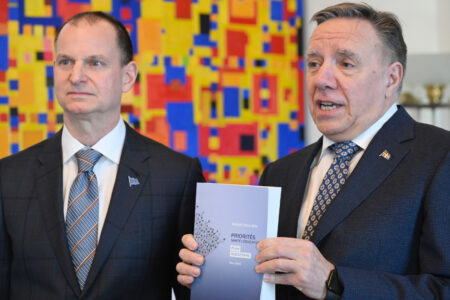
Fiscal federalism has been a frequent point of contention in Canadian politics. Yet, the three territories have received little attention in public debates on the issue. Instead, the provinces, especially Alberta following its recent provincial referendum on equalization, have been the focus.
This is unfortunate. The territories represent unique case studies, due to their limited revenue-generating powers, distinctive demographics, economies, natural resources and political institutions. Our research suggests that the current fiscal relationship the territories have with the federal government may fall short in addressing their future challenges.
To be clear, there have been deep dives into federalism and the territories. The Expert Panel on Equalization and Territorial Formula Financing, for example, or the Mayer Report on Nunavut Devolution, which explored the prospects of natural resource devolution in Nunavut, were important. But new challenges are mounting, and reforms to fiscal federalism affecting the territories should be examined.
For several important reasons, the issues facing the territories are distinct from those facing the provinces.
First, and most important historically – though still relevant today – is control over Crown lands, which is constitutionally within the federal government’s jurisdiction, unlike the situation with the provinces.
While recent devolution agreements have eased this fiscal constraint, it has not been eliminated. For example, the 2014 N.W.T. devolution agreement allows the Northwest Territories to keep half of resource revenues up to a fixed share of its budget needs. The rest goes to the federal government. This is a far cry from the provinces, which receive 100 per cent of natural resource revenues from within their land borders.
Second, while the territories vary on their dependence of natural resources, their economies are all more heavily resource-based than most provinces. This adds volatility to their economies and to their budgets through sometimes large swings in corporate income taxes.
Third, due to vast geographies, dispersed populations, limited infrastructure and several other factors, providing services to Northern residents is more expensive. These factors also inhibit higher levels of economic activity and resource development.
These unique circumstances require unique fiscal arrangements.
Unlike the provinces, the territories do not operate under the federal equalization program. Instead, territories receive territorial formula financing (TFF) transfers. There are important similarities between the TFF and equalization. They are both unconditional transfers from the federal government, and eligible federal transfers are calculated based on fiscal capacity.
Yet, unlike equalization – which is received by some provinces and not by others – the TFF is not a zero-sum game. In other words, all three territories receive federal TFF payments every year.
Natural resource revenues are also treated differently within the TFF than equalization. They are negotiated separately by each territory as part of broader federal-territorial devolution negotiations.
Lastly, in contrast to equalization, which is exclusively based on fiscal capacity, there is a measure of “expenditure need” incorporated into the TFF. This ensures that territorial governments can deliver similar levels of public services. This measure of expenditure need is set through the gross expenditure base (GEB), which is a proxy for the expenditure needs of each territorial government.
The TFF grant entitlement is then calculated by subtracting the provinces total fiscal capacity from the GEB, plus an economic development incentive. We provide the latest data in Table 1.
These transfers are large. On a per-capita basis, the size of the TFF grant (not including the health and social transfers) varies considerably, from slightly less than $27,000 per capita for Yukon to nearly $47,000 for Nunavut. This is well above the levels received by even the most transfer-dependent provinces. The three maritime provinces, for example, received between $4,096 and $4,607 per-capita from the federal government from all major transfers in 2022/23.
But as large as they are, there are important challenges for the territories coming soon. The current TFF may not keep up.
Aging populations, for example, may increase health expenditures in all jurisdictions, but the territories may see particularly large increases. This fact is easily observed using the latest data from the Canadian Institute for Health Information on government health expenditures.
Nationally, provincial governments spend an average of approximately $12,000 per year on health care for individuals over the age of 65, which rises to an average of $21,500 per year for individuals over the age of 80. The territories, however, spend an average of more than $35,000 annually for individuals over age 65 and this rises to more than $90,000 per year for those over 80.
The TFF is not well-suited to help address this mounting source of fiscal pressure because the GEB is tied to changes in per-capita spending in Canada’s South. It will be an increasingly poor measure of fiscal need in Canada’s North.
More research is warranted.
Another key ongoing issue of fiscal federalism in the territories is the devolution of lands and natural resources. For instance, how do such arrangements pertain to Indigenous-settler relations, reconciliation and multi-level governance?
In the N.W.T. and Yukon, for example, Indigenous organizations were involved in the devolution negotiations and were included as signatories to the final agreements. These are much more than bilateral agreements between the federal and territorial governments.
In addition, considering alternative ways of ensuring natural resource development comes with greater fiscal benefits for the territories, especially considering the mounting pressures from aging.
While not an exhaustive list of what a fruitful policy discussion should involve, we believe natural resource development and demographics are central issues for fiscal federalism and the territories. Their experience may also inform policy developments elsewhere in the country.
Not all lessons will be applicable, of course. The territories, after all, have unique political institutions. N.W.T. and Nunavut operate using a non-partisan adaptation of Westminster parliamentary democracy known as “consensus government.” The lack of political parties results in a less overtly-partisan cabinet.
This is relevant to intergovernmental relations and fiscal federalism because it lends itself to fewer hyper-partisan and ideological debates compared to the provinces. Take for example the ongoing tensions between the Trudeau government and Conservative premiers in Western Canada and Ontario.
Continuing to overlook the territories in the study of fiscal federalism would be a great disservice. Their unique historical and institutional legacies, their distinct political dynamics and their unique and growing challenges means improving our understanding of fiscal federalism in Canada’s North must become a renewed priority.













